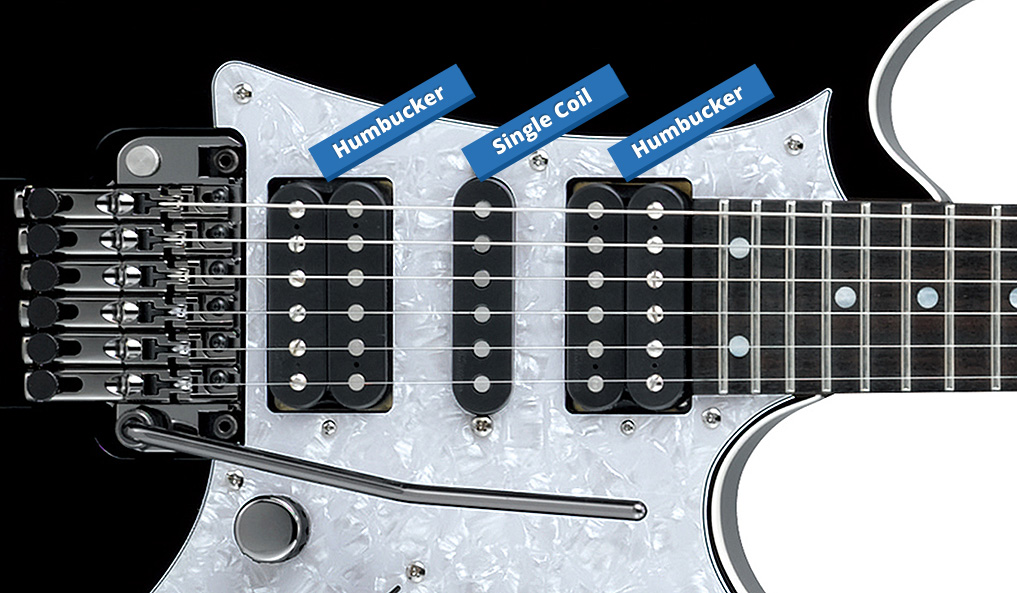Difference in Tonal Quality Due to Position of Guitar Pickups
The reason behind the different tonal qualities of pickups in different positions on the guitar is due to their position along the strings. When a note is played it is not just one note, but a whole range of notes that sound together. For example:

The black lines represent the way in which the string vibrates. Only 3 of the harmonics are shown in the diagram above but there are in fact an infinite number of them each with a different sound. However 3 is enough to illustrate the point I am trying to make. Harmonics are discussed in greater detail in a later chapter, Guitar Harmonics.
If you trace up each of the 3 dotted lines, you will notice that for each pickup, the magnitude of the harmonic content is different. For example, the neck pickup will have the most pronounced 2nd harmonic, whereas the bridge pickup will have the least. It is this difference which defines the unique sound of each pickup.
As a general guide, the bridge pickup will have a sound full of treble, whereas the neck pickup will have the most bass giving it a warm sound.
Difference Between Single Coil and Humbucking Pickups
A Single Coil Pickup and a Humbucking Pickup The visual difference between a single coil pickup and a humbucking pickup (also known as “humbucker”) is shown in the photograph below:

As you can see it’s pretty simple to distinguish between the two types of pickups. So what’s the reason behind having these two types of pickups?
The single coil pickup was the first of the two to be invented. The problem with it was the fact that it not only picked up the sound of the guitar but other unwanted sounds as well, which caused it to be noisy when the guitar was played. The humbucker is the solution to this, and it has been designed to cut out this ‘hum’.
However the way in which the humbucker functions gives it a different sound from the single coil pickups. The single coil typically has a ‘brighter’ (more treble content) sound than the humbucker, whereas the humbucker has a more powerful sound (also produces a louder output).
The two different pickups produce different sounds and therefore you need to choose which suits your playing style best. For example humbuckers would most likely be used by a guitarist playing heavy metal, and single coils by a blues player etc…
How a Guitar Pickup Works
An electric guitar string either is made of solid metal (the G, B, and e strings) or metal wrapped around some material in the centre (the E, A and D strings). This metal is usually nickel.
The pickup works on the principle that when a magnet travels across or through a coil, it produces some electrical output. The pickup in fact consists of both a magnet and a coil. When a string is set into motion by picking it, it becomes magnetised by the magnet in the pickup. The magnetised string then repeatedly moves over the coils producing an electrical signal. This signal is then sent through the cable to the amp where it is amplified by a small amount by a preamp, processed, amplified again to a much greater degree and outputted as sound.
There is a reason for this two step amplification. The signal produced by the pickups in the guitar is in fact very small (much less than 1 volt) and therefore requires to be amplified before any processing, such as equalisation can take place. This amplification is done by a preamp, usually consisting of a component called the FET. The later amplification is so there is enough power to drive the speakers.
- Want to improve your guitar playing?
-
These lessons have been written by me, a guitar enthuthiast. I've written them to the best of my abilities, but I'm no guitar teacher!
If you want award-winning, well structured but inexpensive lessons, I strongly recommend you check out Guitar Tricks. They have great range of video guitar lessons from numerous coaches specialising in a wide range of styles.
I've seen their videos, and they're great. With these guys, I'm confident you'll be improving in no time!
